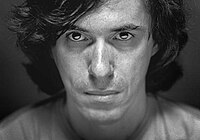Portrait photography
This article needs additional citations for verification. (December 2007) |

Portrait photography (also known as portraiture) is the capture by means of photography of the likeness of a person or a small group of people, in which the face and its expression is predominant. The objective is to display the likeness, personality, and even the mood of the person. Like other types of portraiture, the focus of the photograph is the person's face, although the entire body and the background may be included. A portrait is generally not a snapshot, but a composed image of a person in a still position. A portrait often shows a person looking directly at the camera.
Unlike many other styles of photography, the subjects of portrait photography are non-professional models. Many family portraits and photographs that commemorate special occasions, such as graduations or weddings, are professionally produced and hang in private homes. Most portraits are not intended for public exhibition.
History

Portrait photography has been around since the invention and popularization of the camera. It is a cheaper and often more accessible method than portrait painting, which has been used by distinguished figures before the popularity of the camera.
The relatively low cost of the daguerreotype in the middle of the 19th century lead to its popularity for portraiture. Studios sprang up in cities around the world, some cranking out more than 500 plates a day. The style of these early works reflected the technical challenges associated with 30-second exposure times and the painterly aesthetic of the time. Subjects were generally seated against plain backgrounds and lit with the soft light of an overhead window and whatever else could be reflected with mirrors. As the equipment became more advanced, the ability to capture images with short exposure times gave photographer more creative freedom and thus created new styles of portrait photography.
As photographic techniques developed, photographers took their talents out of the studio and onto battlefields, across oceans and into remote wilderness. William Shew's Daguerreotype Saloon, Roger Fenton's Photographic Van and Mathew Brady's What-is-it? wagon set the standards for making portraits and other photographs in the field.
Contemporary artists Cindy Sherman, Barbara Kruger, Mitch Kern and others use portrait photography as a vehicle for cultural criticism.
Lighting for portraiture

When portrait photographs are composed and captured in a studio, the professional photographer has control over the lighting of the composition of the subject and can adjust direction and intensity.
The basic lighting types are termed main light, fill lights, kicker lights, and background lights. The main light is the primary light source for the portrait. It is positioned about 45 degrees to the left or right of the subject, but it can also be used from above or below. A fill light is usually used opposite of the main light, but farther away or with less intensity. It is used to soften hard shadows created by the main light. Kicker lights (also called hair lights or side lights) provide lighting to the hair of the subject. This helps add depth to the photo and can be used to separate the subject from the background. Background lights are those which do not fall on the subject but the background. They can provide interesting effects to a boring backdrop or be used to make a background appear pure white.
Most lighting found in modern photography are usually a flash of some sort. The lighting for portraiture is typically diffused by bouncing it from the inside of an umbrella, or by using a soft box. The soft box is essentially a strobe encased in an opaque box and one side is made of translucent fabric material. This provides a softer lighting for portrait work and is considered visually more appealing. Hair and background lights are usually not diffused. It is more important to control light spillage to other areas of the subject. Snoots and barn doors help focus the lights exactly where the photographer wants them. Background lights are sometimes used with color gels placed in front of the light to create colorful backgrounds.
There are many different techniques for portrait photography. Often it is desirable to capture the subject's eyes and face in sharp focus while allowing other less important elements to be rendered in a soft focus. At other times, portraits of individual features might be the focus of a composition such as the hands, eyes or part of a torso.
See also
References
